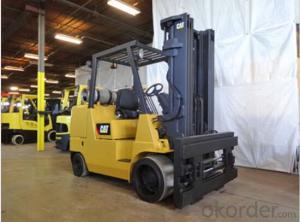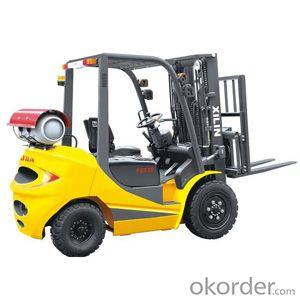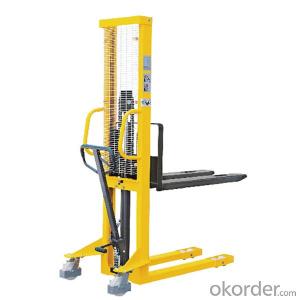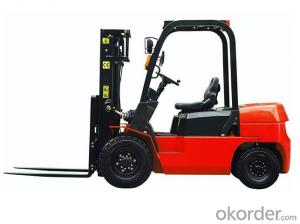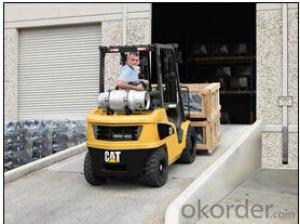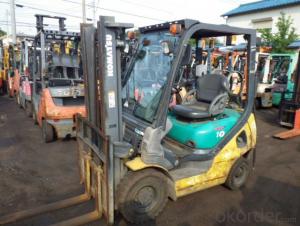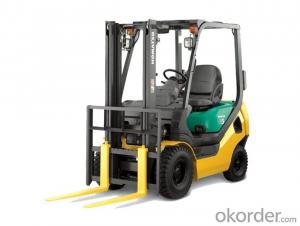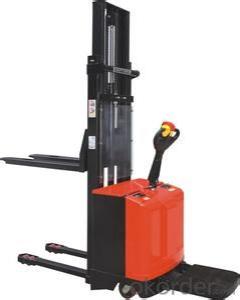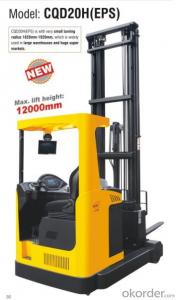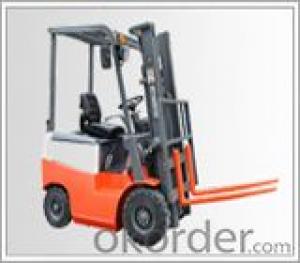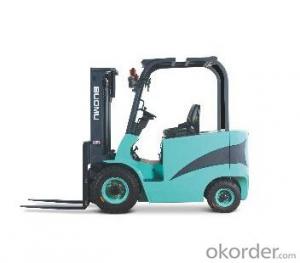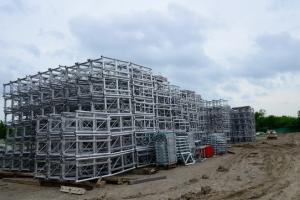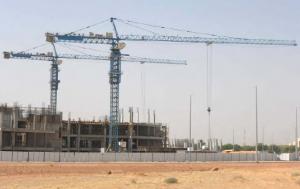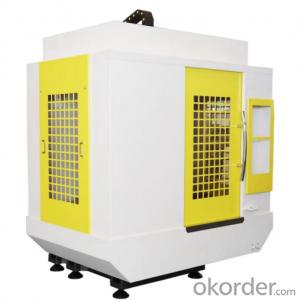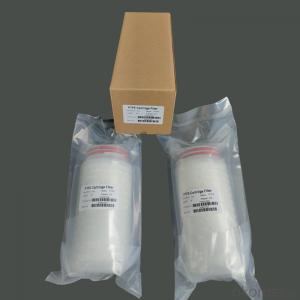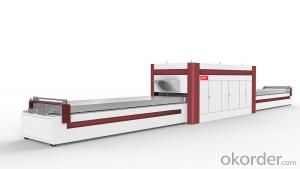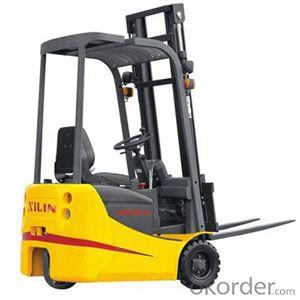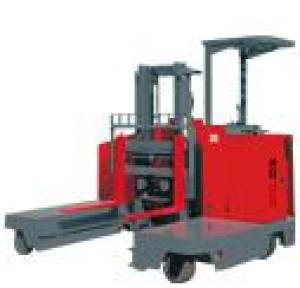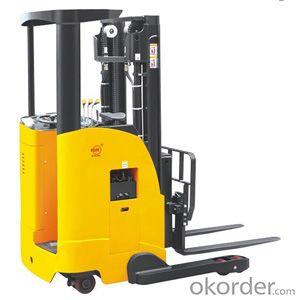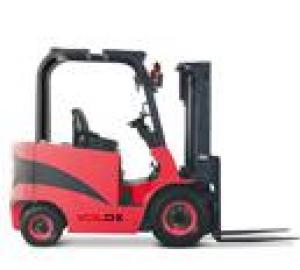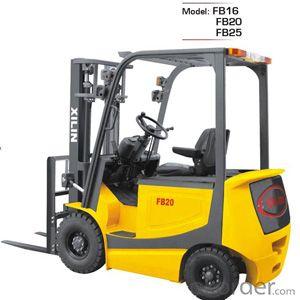FORKLIFT SERIE - BATTERY FORKLIFT - CMAXFE3R16AC
- Loading Port:
- Shanghai
- Payment Terms:
- TT or LC
- Min Order Qty:
- 1 unit
- Supply Capability:
- 1 unit/month
OKorder Service Pledge
OKorder Financial Service
You Might Also Like
Description of forklift:
A forklift truck (also called a lift truck, a fork truck, or a forklift) is a powered industrial truck used to lift and move materials short distances. The forklift was developed in the early 20th century by various companies including the transmission manufacturing company Clark and the hoist company Yale & Towne Manufacturing. Following World War II the use and development of the forklift truck has greatly expanded worldwide. Forklifts have become an indispensable piece of equipment in manufacturing and warehousing operations. In 2013 alone the top 20 manufacturers worldwide posted sales of $30.4 billion with 944,405 machines sold.;and the U.S. forklift market was nearly $33 billion.
A forklift truck being used during World War II
The middle nineteenth century through the early twentieth century saw the developments that led to today's modern forklifts. The forerunner of the modern forklift were manually powered hoists that were used to lift loads. In 1906 the Pennsylvania Railroad introduced battery powered platform trucks for moving luggage at their Altoona, Pennsylvania train station. World War I saw the development of different types of material handling equipment in the United Kingdom by Ransomes, Sims & Jefferies of Ipswich. This was in part due to the labor shortages caused by the war. In 1917 Clark in the United States began developing and using powered tractor and powered lift tractors in their factories. In 1919 the Towmotor Company, and Yale & Towne Manufacturing in 1920, entered the lift truck market in the United States. Continuing development and expanded use of the forklift continued through the 1920s and 1930s. The introduction of hydraulic power and the development of the first electric power forklifts, along with the use of standardized pallets in the late 1930s, helped to increase the popularity of forklift trucks.
The start of World War II, like World War I before, spurred the use of forklift trucks in the war effort. Following the war, more efficient methods for storing products in warehouses were being implemented. Warehouses needed more maneuverable forklift trucks that could reach greater heights and new forklift models were made that filled this need. For example, in 1954 a British company named Lansing Bagnall, now part of KION Group, developed what was claimed to be the first narrow aisle electric reach truck.The development changed the design of warehouses leading to narrower aisles and higher load stacking that increased storage capability.During the 1950s and 1960s operator safety became a concern due to the increasing lifting heights and capacities. Safety features such as load back rests and operator cages, called overhead guards, began to be added to forklifts produced in this era. In the late 1980s ergonomic design began to be incorporated in new forklift designs to improve operator comfort, reduce injuries and increase productivity. During the 1990s exhaust emissions from forklift operations began to be addressed which led to emission standards being implemented for forklift manufacturers in various countries. The introduction of AC power forklifts, along with fuel cell technology, are also refinements in continuing forklift development In 2011, the size of the forklift manufacturing industry was nearly $27 billion.
Technical data of forklift:
1KG=2.2LB 1INCH=25.4MM
Mast table FE3R16AC | Capacity table(kg) c=500mm | Truck | |||||||
| Designation | Lift height | Free lift | Closed mast height | Extended mast height | Forward backward tilt | FE3R16AC | Width | Truck | |
| h3 mm | h2 mm | h1 mm | h4 mm | α/β(°) | Without sideshift | With sideshift | mm | mm | |
| two-stage | 2500 | 145 | 1650 | 3420 | 3/6 | 1600 | 1600 | 1030 | 858 |
| 2700 | 145 | 1850 | 3620 | 3/6 | 1600 | 1600 | 1030 | 858 | |
| 3000 | 145 | 2000 | 3920 | 3/6 | 1600 | 1600 | 1030 | 858 | |
| 3300 | 145 | 2150 | 4220 | 3/6 | 1600 | 1500 | 1030 | 858 | |
| 3600 | 145 | 2300 | 4520 | 3/6 | 1500 | 1400 | 1030 | 858 | |
| 4000 | 145 | 2500 | 4920 | 3/6 | 1350 | 1250 | 1030 | 858 | |
| 4300 | 145 | 2650 | 5220 | 3/6 | 1200 | 1100 | 1030 | 858 | |
| 4500 | 145 | 2750 | 5420 | 3/6 | 1050 | 900 | 1030 | 858 | |
| two-stage full free | 2500 | 1200 | 1650 | 3420 | 3/6 | 1600 | 1600 | 1030 | 858 |
| 2700 | 1300 | 1850 | 3620 | 3/6 | 1600 | 1600 | 1030 | 858 | |
| 3000 | 1500 | 2000 | 3920 | 3/6 | 1600 | 1500 | 1030 | 858 | |
| 3300 | 1700 | 2150 | 4220 | 3/6 | 1600 | 1500 | 1030 | 858 | |
| 3600 | 1800 | 2300 | 4520 | 3/6 | 1500 | 1400 | 1030 | 858 | |
| 4000 | 2000 | 2500 | 4920 | 3/6 | 1350 | 1250 | 1030 | 858 | |
| three-stage | 4000 | 1300 | 1895 | 4920 | 3/6 | 1250 | 1150 | 1030 | 858 |
| 4300 | 1400 | 1905 | 5220 | 3/6 | 1150 | 1050 | 1030 | 858 | |
| 4500 | 1500 | 1955 | 5420 | 3/6 | 1050 | 950 | 1030 | 858 | |
| 4800 | 1600 | 2055 | 5720 | 3/6 | 900 | 750 | 1030 | 858 | |
| 5000 | 1700 | 2105 | 5920 | 3/6 | 750 | 600 | 1030 | 858 | |
| Identification | Manufacturer’s type designation | FE3R16AC | |
| Drive:electric(battery or mains),diesel, petrol gas,manual | electric | ||
| Type of operation : hand ,pedestrian ,standing, seated,order-picker | seated | ||
| Load Capacity /rated load | Q (kg) | 1600 | |
| Load center distance | C(mm) | 500 | |
| Load distance, centre of drive axle to fork | X(mm) | 330 | |
| Wheelbase | y(mm) | 1207/1304 | |
| Weights | Service Weight ind,battery(see line 6.5) | Kg | 3034 |
| Axle loading, laden front/rear | Kg | 4170/464 | |
| Axle loading, unladen front/rear | Kg | 1214/1820 | |
| Wheels, Chassis | Tyres:solid rubber, superelastic, pneumatic, polyurethane) | SE | |
| Tyre size, front | 457x178x308 | ||
| Tyre size, rear | 18x7-8 | ||
| Wheels, number front/rear(x=driven wheels) | 2x/1x | ||
| Track width,front | b10(mm) | 884 | |
| Track width,rear | b11(mm) | - | |
| Basic Dimensions | Mast/fork carriage tilt forward/backward | α/β(°) | 3/6 |
| Lowered mast height | h1(mm) | 2150 | |
| Free lift | h2(mm) | 145 | |
| Lift height | h3(mm) | 3300 | |
| Extended mast height | h4(mm) | 4159 | |
| Overhead load guard height | h6(mm) | 1990 | |
| Seat height/standing height | h7(mm) | 950 | |
| Coupling height | h10(mm) | 432 | |
| Overall length | l1(mm) | 1869 | |
| Length to face of forks | l2(mm) | 1869 | |
| Overall width | b1/b2(mm) | 1060 | |
| Fork dimensions | s/e/l(mm) | 100x35x920 | |
| Fork carriage width | b3(mm) | 980 | |
| Ground clearance,laden, under mast | m1(mm) | 100 | |
| Ground clearance, center of wheelbase | m2(mm) | 110 | |
| Aisle width for pallets 1000x1200 crossways | Ast(mm) | 3069 | |
| Turning radius | Wa(mm) | 1539 | |
| Performance Data | Travel Speed, laden/unladen | km/h | 10/10 |
| Lift speed, laden/unladen | mm/s | 240/400 | |
| Lowering speed, laden/unladen | mm/s | 400/300 | |
| Gradient performance,laden/unladen S2 30min | % | 10/15 | |
| Service brake | hydr./mech. | ||
| E-Motor | Drive motor rating s2 60min | kw | 5 |
| Lift motor rating at s3 15% | kw | 7.5 | |
| Battery voltage, norminal capacity K5 | V/Ah | 48/400 | |
| Battery weight | kg | 665 | |
| Others | Type of drive control | AC | |
| Operating pressure for attachments | MPa | 14.5 | |
| Sound level at driver’s ear according to EN12053 | dB(A) | 75 |
Images of forklift:
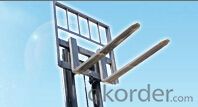
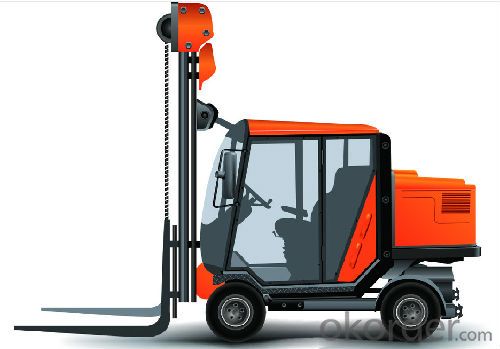

FAQ of forklift:
Q: What’s the function of forklift?
A: A forklift truck (also called a lift truck, a fork truck, or a forklift) is a powered industrial truck used to lift and move materials short distances. The forklift was developed in the early 20th century by various companies including the transmission manufacturing company Clark and the hoist company Yale & Towne Manufacturing. Following World War II the use and development of the forklift truck has greatly expanded worldwide. Forklifts have become an indispensable piece of equipment in manufacturing and warehousing operations.
Q: What’s the general operations of forklift:
A: Forklift cab with control layout.
Forklifts are rated for loads at a specified maximum weight and a specified forward center of gravity. This information is located on a nameplate provided by the manufacturer, and loads must not exceed these specifications. In many jurisdictions it is illegal to remove or tamper with the nameplate without the permission of the forklift manufacturer.
Q: What are the Forklift safety Standards?
A: 1, Forklift safety is subject to a variety of standards world wide. The most important standard is the ANSI B56—of which stewardship has now been passed from the American National Standards Institute (ANSI) to the Industrial Truck Standards Development Foundation after multi-year negotiations. ITSDF is a non-profit organization whose only purpose is the promulgation and modernization of the B56 standard.
2, Other forklift safety standards have been implemented in the United States by the Occupational Safety and Health Administration (OSHA) and in the United Kingdom by the Health and Safety Executive.
3, Driver safety: In many countries forklift truck operators must be trained and certified to operate forklift trucks. Certification may be required for each individual class of lift that an operator would use.
- Q:What is the difference between the series of internal combustion forklifts
- Together there are K, alpha Ⅱ H2000, G series, the K series 2-5 tons, alpha Ⅱ system for alpha upgrade is usually 4 -- 10 tons, the two series car belongs to the common sense of the civilians, high quality and low price. H2000 series for 1-20 tons, G series is 1-3.5 tons, 20-46 tons, belongs to the high-end car, each configuration includes the engine, transmission ratio K, alpha Ⅱ series, especially G system for the latest research and development products, and configuration of imports, the price also very similar to the imported cars, belong to large and medium-sized enterprises and export models.
- Q:What is the difference between a forklift and a trailer for a hydraulic drive?
- Just like the manual, you can hang up the gear without stepping on it, and only go forward and backward. It's better than manual. The left side is going down, and the handle on the right is leaning forward, and then backwards. Actually, you go to the scene and you have to try it first. Step on the brakes and try to go down. this
- Q:What oil do you use for forklift
- Go to a regular agent or service center because there are fake products in the market and avoid unnecessary losses.
- Q:How to test a forklift
- There are many places on the Internet where you can check your forklift.
- Q:What about the exhaust fumes of the internal combustion fork in the workshop
- There is a bias towards the diesel fuel and not more than the other is to modify the exhaust system of the engine and the exhaust system is more expensive
- Q:How does the fork of a forklift know that there is no balance
- Overload detection is the most important thing. This is the prevention of damage to the goods for deformation.
- Q:Why is the forklift water tank heating?
- To open the tank cover the first cycle is good (poor circulation pump) engines will bring a poor circulation or water tank is dirty To unload the water tank Looking for professionals to open it to extract the dirty things inside In general the cooling system The worst is the gasket before open the tank by the bubbles If you don't water shortage The general or not
- Q:Is a forklift and a hug a car
- To lift a car is to add a harness to the forklift truck Assemble in front of the door For holding the paper roll The handle and operation mode of the holding clamp are the same as the operation of the fork in the ordinary forklift truck
- Q:What type of work is the forklift worker in the new labor law
- You should look at you with the original state-owned enterprises to sign labor contract, time to what time, if the contract did not end, unit of choose and employ persons cannot be unilaterally change.
- Q:The photo of the forklift card is a few inches. Is it colorful?
- I am a forklift driver training, as long as one inch of color picture is ok, the free crown, do not need blue bottom.
1. Manufacturer Overview |
|
|---|---|
| Location | |
| Year Established | |
| Annual Output Value | |
| Main Markets | |
| Company Certifications | |
2. Manufacturer Certificates |
|
|---|---|
| a) Certification Name | |
| Range | |
| Reference | |
| Validity Period | |
3. Manufacturer Capability |
|
|---|---|
| a)Trade Capacity | |
| Nearest Port | |
| Export Percentage | |
| No.of Employees in Trade Department | |
| Language Spoken: | |
| b)Factory Information | |
| Factory Size: | |
| No. of Production Lines | |
| Contract Manufacturing | |
| Product Price Range | |
Send your message to us
FORKLIFT SERIE - BATTERY FORKLIFT - CMAXFE3R16AC
- Loading Port:
- Shanghai
- Payment Terms:
- TT or LC
- Min Order Qty:
- 1 unit
- Supply Capability:
- 1 unit/month
OKorder Service Pledge
OKorder Financial Service
Similar products
New products
Hot products
Hot Searches
Related keywords
